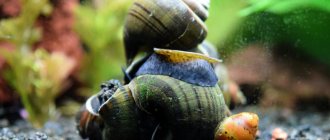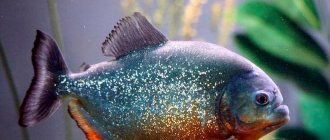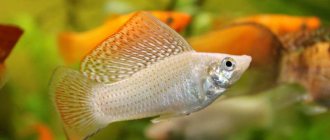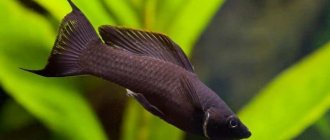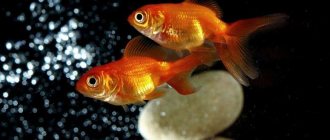Mollies are a popular aquarium fish, distinguished by their richly colored scales and easy-going nature. Many aquarists keep the phenotype both in a separate and in a species tank, and of course, they breed mollies. Before embarking on such a responsible task, you should know how aquarium fish reproduce, how mollies directly give birth, and how to raise mollies fry at home.
General characteristics of the species
Mollies are aquarium fish from the genus Poeciliidae, belonging to the order Cyprinodontiformes. The main feature of the phenotype is that molly is a viviparous fish, and is capable of bearing and giving birth to offspring that are completely ready for independent life immediately after birth. In the wild, molly fish look modest and inconspicuous, but in pet stores, thanks to the painstaking work of breeders, you can see many different ornamental fish species that differ in color and body shape. The color of molly scales varies from jet black to white and orange, and the body shape can be disc or balloon.
Interesting fact: only this species can have a “balloon” body shape. In balloon mollies, reproduction occurs in the same way as in other relatives.
Sexual dimorphism
It is not difficult to distinguish a male molly from a female. These aquarium fish have quite pronounced sexual dimorphism. This is due precisely to the fact that the species is viviparous. The question of choosing manufacturers should not cause difficulties even for novice aquarists.
The main sexual differences in mollies are:
- Gonopodium. The modified anal fin is the main feature that distinguishes female and male individuals. It has the shape of a cone-shaped gutter. During mating, the male's milk enters the female's body along the fin. In females, the anal fin is triangular in shape.
- Dimensions. Males are smaller compared to females. Females have a thick body and a rounded abdomen.
There is a hook on the gonopodium, with which the male clings to the female during fertilization. This significantly increases the chances of successful offspring.
Features of reproduction
Spawning of mollies can take place only at 5–6 months in females, and at 8–12 months in males, since it is at this age that the fish begin puberty. To avoid hassles, aquarists choose not a couple of molly fish for breeding, but four individuals: one male and three females. After a pregnant molly gives birth, fertilized eggs remain in its body, and even if the breeding male is removed from the aquarium, the females can still reproduce. In a pregnant molly, birth occurs after 20–40 days, the duration depends on the water temperature. Also a distinctive feature of the phenotype is the ability to change sex if the preservation of the population requires it.
Manufacturers' choice
You need to choose the right manufacturers. There must be at least three females per male. You will also need to consider the following parameters:
- choose fully active individuals (this indicates the health of the fish);
- Look for damage to the fins, spots on the body or other signs of disease;
- pay attention to the color (sort out representatives of the species with uniform, rich tones of the body and fins);
- choose large fish, that is, those that have reached reproductive age.
Selected breeders must be fed plant foods for 10–15 days before mating.
How to distinguish a female from a male
Before you breed molly, you need to be able to distinguish between male and female molly. Experienced aquarists are guided by the following external signs:
- boys are smaller in size, the anal fin is presented in the form of a genital organ, and the caudal fin is lush and large;
- girls are larger and more plump, and the anal fin has a triangular shape.
The sex of a fish can be determined at 6–8 weeks of life, and its formation depends on the temperature of the liquid in the general aquarium: boys predominate in warm water, and females predominate in cold water.
Conditions necessary to produce healthy offspring
In most cases, the reproduction of mollies occurs without difficulty, however, it will require the owner of these cute creatures to create comfortable conditions.
To successfully breed new generations of mollies, you will need:
- Spacious aquarium.
- Pure water without impurities, enriched with oxygen.
- The presence of shelters in the form of snags, dense thickets, rocky areas.
Pregnant female.
Breeding mollies in a community aquarium is not recommended. When the female’s pregnancy becomes obvious, the fish will need to be placed in a vessel with a volume of 60-100 liters of warm water (within 25-28 degrees). It is advisable to do this a few days before the expected “birth”.
The imminent arrival of this moment will be indicated by the behavior of the aquarium fish itself. Most often, the female begins to actively look for a place where she can safely hide. If babies begin to be born soon, the shape of the abdomen changes noticeably - from round it becomes square .
The aquarium should be rich in thick algae. The female must be transplanted very carefully so as not to provoke premature spawning. Proper maintenance of pregnant mollies involves a varied, rich diet. The omnivorous nature of the fish allows you to offer it live, plant or dry food.
Before labor occurs, it is important to constantly monitor the water temperature. If the reading is more than 28°C, the fry may be born premature, which significantly reduces their chances of survival.
Preparing fish for breeding
Mollies give birth and reproduce only in certain conditions, otherwise pregnancy may not occur, or the offspring will be premature. You can breed fish in a common aquarium, but experts advise placing the parents in a separate container so that nothing distracts or disturbs the pets. The spawning tank is prepared as follows:
- volume is selected from 60 l;
- living vegetation is planted in the nursery;
- daylight hours should last 12 hours;
- water acidity – 7–8 pH;
- hardness – 20–30 dH;
- temperature – 26–28C.
To obtain healthy offspring, the best fish are selected, among which there should be three females and one male. The selection is made according to the following criteria:
- pet activity and mobility;
- fin integrity;
- brightness and uniformity of color, absence of stains or plaque;
- fish size;
- belonging of future parents to the same species.
Before transplanting the fish into the nursery, it is necessary to keep the future parents on plant feeding for two weeks. Mollies begin breeding one or two months after moving to the spawning ground: the male fertilizes the female using the genitals, and the first attempts may be unsuccessful.
Interesting fact: Molly fry are almost always born at dawn.
Possible diseases
Fry are susceptible to diseases, like all other living beings. It is important to detect the disease in time and try to eliminate it. Small fish often encounter the following ailments:
- The fish's restlessness and darkening of its gills may indicate that there is too much oxygen in the water, and the pet begins to develop a gas embolism. To cope with the disease, you need to change the water to a composition suitable for mollies.
- If the conditions of detention are violated, then the pets may begin to develop a tumor. It is impossible to help in this case, and the fish will die.
- When the fish has lost interest in food, begins to swim near the surface, and loses activity, this may indicate that the water is too cold and the mollies have caught a cold. In this case, you need to monitor the temperature in the aquarium as carefully as possible and not let it drop.
Mollies are quiet and calm fish that get along well in an aquarium with the same individuals. Under no circumstances should you place them with predators; they will become a snack. These fish are not very demanding and live up to 5 years. Given comfortable conditions and proper nutrition, they can live for 8 years.
In this video you will learn more about this fish:
How to determine pregnancy
Considering the fact that fertilization does not occur the first time, many aquarists are thinking about how to determine the pregnancy of mollies. It should be noted that only producers of the same species need to be crossed in order to obtain uniformly colored and beautiful offspring. In pregnant mollies, the abdomen is significantly rounded and protrudes, so it is easy to notice the interesting position of the fish. Breeding fish can produce offspring within six months after mating, since fertilized eggs are stored in their bodies. Before giving birth, the fish becomes anxious and restless, begins to rush around the aquarium, and the abdomen takes the shape of a rectangle. Mollies give birth on average in 3–6 hours, producing each baby in turn, and it is extremely important not to miss the moment when molly fry are born - from 10 to 200 pieces. The fact is that the mother poses a threat to the babies, since she is not averse to feasting on the offspring, so the fish are quickly put into the old reservoir.
Interesting fact: the number of babies born depends on the size of the mother.
Mollies Dalmatian
The color of the Dalmatian Mollies is silver with a large number of black small and medium-sized spots. A freshwater fish that, in its natural environment, can live in fresh and brackish water and in the slow-moving waters of Central and South America. She loves warmth, and a comfortable temperature will be from +24 to +28 °C. In cooler water it begins to hurt, this can be seen by the typical rocking movements.
This fish is best kept in a school; if it is not in a school, it may begin to get sick. Males of Dalmatian Mollies reach a body length of 4 to 6 cm, females become much larger - from 6 to 10 cm. An aquarium from 80 liters is suitable. The more space a Dalmatian has, the more beautiful it becomes. Males can be identified by their gonopodium, an elongated reproductive organ at the base of the tail. Females do not have this and are more rounded than the male.
Caring for fry
Small born mollies are independent and mobile, but despite this, caring for the fry is necessary. The main thing for growing viable and healthy fish is information on what to feed molly fry and how to care for the babies.
Molly offspring reach 7 mm in length, however, the endurance of the species is much less than that of other phenotypes, so it is important to look after the molly fry at first. After birth, the babies lie on the leaves or ground for some time, and then begin to move in search of food. Feed small molly 3-4 times a day, giving small portions of the following foods:
- Daphnia;
- tubifex;
- Cyclops;
- crushed dry food;
- Artemia;
- microworms;
- ciliates.
Thanks to live and protein food, the fry grow faster, and very soon they will turn into well-fed and adult fish. Feed portions are gradually increased.
Vinegar eel
The easiest live food to breed at home is the vinegar eel. Acetic eel has additional names: microfeed, microworm and nematode. To breed eel, you will need a shallow plastic container with a closing lid. The vinegar eel feeds on the vinegar produced when flour products, such as bread or oatmeal, sour.
For feeding, you can use oatmeal porridge or just soaked bread. Making oatmeal porridge is very simple. Rolled oats flakes ground in a coffee grinder should be brewed with boiling water and cooled. The resulting mass should resemble batter. To increase carotene in the worm, you can add grated carrots to the feeding.
Natural habitat
Mollies are an aquarium fish of the genus Poeciliidae. In the natural environment, these fish quickly adapt, easily find food for themselves and are perfectly compatible with sea and river inhabitants. These fish were brought to Europe in the 20th century from the South American continent. The breeding of these “settlers” began in the 40s. Hybrids began to appear at the beginning of the 20th century. Their population is growing day by day.
It's nothing special. Its natural color is gray-silver, black spots are distributed throughout the body, darkening is located around the eyes of the mollies. It looks like an ordinary fish, but aquarium inhabitants are a completely different matter. The aquarium fish market is full of variety. They come in different colors: silver, orange, variegated, white. These peaceful inhabitants of the aquatic environment are not at all aggressive and have good health.
Advice: for beginners, you need to make a choice in favor of small fin mollies and its hybrids. They can live longer in small aquariums. And, compatibility with other fish makes this species practical and unique.
Aulophorus
Aulophorus worms are an excellent valuable and nutritious food for mollies fry. In the first week, the aulophorus for mollies fry will be still large, so before feeding it, it must be crushed, cut with a blade on a small piece of rubber or glass, then washed in a net made of thick fabric. Breeding Aulophorus is not difficult. Aulophorus is bred on foam sponges, placing them in a low plastic container with a closing lid. Sponges are placed in a container and filled with aquarium or tap water so that the upper part of the sponges remains 2-3 mm unflooded with water.
A cast of worms is placed on the surface of the sponges, sprinkled with food and covered with a lid. To feed Aulophorus you can use: grass flour, boiled carrots, spirulina or crushed rolled oats. It is believed that the best results are obtained from crushed rolled oats (oatmeal). The culture of worms must be allowed to multiply and for 2-3 weeks the aulophorus is only fed, adding fertilizer as it is eaten and the water is changed every 1-2 days.
Changing the water is carried out by lightly squeezing the sponges directly in the container by lightly pressing and replacing the water several times. Aulophorus worms remain in the drained water; to filter them, you need to drain the water from the container through a net made of dense fabric (tulle, organza, veil). The collected worms can be returned to the sponge or fed to the fish. Worms are collected for feeding with tweezers and washed in a net. If the worms are clean without any additives, they don’t need to be washed. Read more about breeding Aulophorus...

